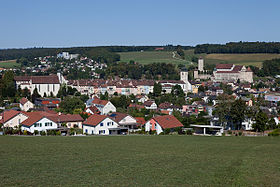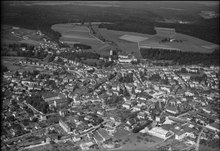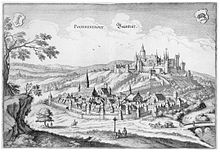Pruntrut
| Pruntrut | |
|---|---|
| State : |
|
| Canton : |
|
| District : | Porrentruy |
| BFS no. : | 6800 |
| Postal code : | 2900 |
| UN / LOCODE : | CH PRY |
| Coordinates : | 572 770 / 251979 |
| Height : | 443 m above sea level M. |
| Height range : | 407-581 m above sea level M. |
| Area : | 14.76 km² |
| Residents: | 6678 (December 31, 2018) |
| Population density : | 452 inhabitants per km² |
| Website: | www.porrentruy.ch |
|
Pruntrut |
|
| Location of the municipality | |
Pruntrut ( French Porrentruy [ pɔʀɑ̃tʀɥi ], familial [ pɔʀɑ̃ ], in the local dialect [ ɛ pwɛrɛ̃'try ]) is a small town, political municipality and capital of the district of the same name in the Swiss canton of Jura and the Ajoie region .
geography
Pruntrut lies at 443 m above sea level. M. , 21 kilometers west-northwest of the canton capital Delsberg (linear distance ). The city extends in a wide valley on both sides of the Allaine , in the Ajoie (German Elsgau ), at the northern foot of the Chain Jura . The stately old town of Porrentruy is in a slightly elevated position.
The area of the 14.8 km² municipal area includes the wide valley of the Allaine in the central part. From the southwest the Creux-Genat also flows into a wide valley , which is fed by a karst spring that only flows periodically. In the south, the area extends to the heights of La Banné ( 511 m above sea level ) and La Perche ( 526 m above sea level ), with the gorge-like valley of the Fontenais stream in between. At Pruntrut, the Allaine turns from its previously westward flow direction to the north and cuts through the Ajoie plateau here . To the west of this valley, the hills and forests of Petit Fahy ( 543 m above sea level ) and Grand Fahy ( 570 m above sea level ) belong to Pruntrut. The highest point of the municipality is on the ridge of Bure with 580 m above sea level. M. achieved. To the north, the municipality extends into the Bois de Sapins ( 530 m above sea level ), and the eastern boundary is the dry valley Combe Vaumacon . In 1997, 20% of the municipal area was settled, 41% forest and woodland, 38% agriculture, and a little less than 1% was unproductive land.
Numerous individual farms belong to Pruntrut. Neighboring municipalities of Pruntrut are Fontenais , Bressaucourt , Courtedoux , Bure , Courchavon , Coeuve , Alle and Courgenay .
history
The first known settlement of the region of Pruntrut goes back to the Gallo-Roman era. In 1983 the remains of a temple (fanum) from this period were discovered near the cemetery on the northern outskirts; Roman coins were also found.
Pruntrut is mentioned for the first time in 1136 under the name de Purrentru . The place name is probably derived from an old French pont de Ragintrudis ("Bridge of the Ragintrud"). Ragentrud was the wife of the Frankish king Dagobert I, who died in 639. The German form of the name is based on a variant with r-metathesis, as it is documented from about 1136 (Punrentrut) . Old interpretations like brun-trut ("druid fountain") are unfounded. In terms of folk etymology , it can be traced back to truite ("trout"), which is the interpretation found in the city's coat of arms.
The settlement initially belonged to the County of Mömpelgard (Montbéliard) before it came to the Principality of Basel for the first time in 1271 . After Pruntrut had been taken by the Burgundians in 1283 , King Rudolf I of Habsburg occupied the city and forced the territory to be returned to the prince-bishopric. At the same time, he raised Pruntrut on April 20, 1283 to a free imperial city. Due to financial difficulties, the prince-bishop had to pledge the Ajoie together with pruntrut to the Lords of Mömpelgard in 1386. In 1461 it came back under the rule of the principality. Due to the Reformation in Basel , Prince-Bishop Melchior von Lichtenfels moved his official seat to Pruntrut in 1527, where he was also a secular ruler and involved in the Pruntrut salt dispute.
Under Prince-Bishop Jakob Christoph Blarer von Wartensee , who ruled from 1575 to 1608, the city experienced a heyday. During his time the castle was renovated and expanded, as well as the foundation of the Jesuit college (1591). The period of prosperity ended abruptly in 1618 with the outbreak of the Thirty Years' War , during which Pruntrut was besieged, occupied and looted several times.
In 1792, French troops captured the Ajoie. Pruntrut became the capital of the Raurak Republic , which was dependent on France , until it was annexed to France in 1793 and merged into the Département du Mont-Terrible . As the capital of this department, however, Pruntrut continued to be important. It was not until 1800, when Mont Terrible was integrated into the Haut-Rhin department , that Pruntrut was degraded to the seat of a sub-prefecture. In 1815, following a resolution by the Congress of Vienna , the city was awarded to the canton of Bern as compensation for Vaud, which was "lost" in 1803 . The synagogue , built in 1874, was demolished in 1983.
Up until the beginning of the First World War , Pruntrut was considered the spiritual center of the Bernese Jura and also had more inhabitants than Delsberg . With the development of road traffic, however, the importance of the city declined due to its peripheral location in Switzerland, and economic stagnation set in. In the second half of the 20th century tensions arose between the small Catholic, French-speaking and the larger Protestant, German-speaking part of the Canton of Bern. As a result, after several regional and federal votes, the French-speaking canton of Jura was founded on January 1, 1979 . To the annoyance of the residents of the Ajoie, however, Delsberg became the capital of the new canton. In 1988 Pruntrut received the Wakker Prize for the exemplary maintenance of the historic center.
Postal history
On February 15, 1856, the telegraph office was opened in the building of the “Hôtel des Halles” (until 1879 “Hôtel de l'Ours”) . The building, built in 1766, originally served as accommodation for guests of the prince-bishops and as a granary. Almost 30 years after the arrival of the telegraph, the local telephone network was put into operation in Pruntrut in 1885 and the switchboard was also located in the Hôtel des Halles. In the early years, it served to network eleven clearly structured subscribers. However, the number of subscribers increased continuously and in 1889 the first interurban telephone connection to Delémont was established. After the turn of the century, Saignelégier (1902), Basel (1903) and the French Delle (1905) were added. In 1949 the telephone office was finally automated. On April 12, 1972, the 116-year-long stay in the "Hôtel des Halles" ended and the PTT moved to the switchboard built especially for this purpose.
population
| Population development | |
|---|---|
| year | Residents |
| 1809 | 2355 |
| 1818 | 1896 |
| 1850 | 2880 |
| 1870 | 4452 |
| 1900 | 6959 |
| 1910 | 6591 |
| 1930 | 5805 |
| 1950 | 6523 |
| 1960 | 7095 |
| 1970 | 7827 |
| 1980 | 7039 |
| 1990 | 6857 |
| 2000 | 6753 |
| 2005 | 6593 |
With 6,678 inhabitants (as of December 31, 2018), Pruntrut is the second largest municipality in the canton of Jura in terms of population. 89.5% of the residents are French-speaking, 2.8% German-speaking and 2.2% Italian-speaking (as of 2000). The highest population was recorded in 1970 with 7827 inhabitants. Since then, the population has steadily decreased, especially during the recession of the 1970s.
economy
Pruntrut is the regional economic center of the Ajoie. In the course of the 19th century it developed from an agricultural to an industrial city. Traditional industries are watchmaking , the manufacture of shoes and the textile industry . During the 20th century, metal processing , machine tool construction , microtechnology and the manufacture of office furniture and electronic devices were added. There are numerous other jobs in the service sector, while agriculture is only of minor importance. The employed are distributed across the three sectors as follows: 2% in the 1st sector, 48% in the 2nd sector and 50% in the service sector.
The city is the seat of numerous institutions, such as the cantonal court, the canton library, the cantonal bank of the canton of Jura, the cantonal office for the preservation of monuments and the archives of the former diocese of Basel. Pruntrut also has a regional hospital located west of the city on the southern slope of the Table Jura plateau.
culture and education
There are several museums in Pruntrut, including the Musée de l'Hôtel-Dieu with a collection of engravings and posters and the Jurassic Museum of Natural Sciences with a botanical garden ( Jardin botanique de Porrentruy ), which was founded in 1795. In addition, the Université populaire jurassienne and the Société jurassienne d'Emulation, an association that strives to promote the cultural unity of the Jurassic people, have their headquarters in the city.
As a regional educational center, Pruntrut is home to numerous schools. The city is home to the cantonal school, several secondary schools, a business school and a school for arts and crafts, the teachers 'seminar, into which the Delémont teachers' seminar was also integrated in 1979, schools for watchmaking and microtechnology, and several private schools.
Healthcare
The place has a public hospital with 24-hour emergency care. It is part of the hospital network of the Hôpital du Jura .
traffic
The city is accessed from Switzerland
- by the A16 motorway . In 1998 the first section was opened on Jurassic soil from Delsberg to Pruntrut. The city's southern bypass with two 1 km long tunnels was opened to traffic in 2005. By 2015, the A16 should be connected to both the Swiss national road network and the French motorway network. Pruntrut is located on the main road from Delémont via the Boncourt border crossing to Belfort in France . A branch road leads from Pruntrut directly to Montbéliard ;
- through Hauptstrasse 6 . This leads from Gletsch to the French border and from there onwards the former Route nationale 19bis (D19) to Belfort.
- indirectly through the former French Route nationale 73 (D73 & D473). Their connecting route between their two parts ran through Switzerland and in this course also through Pruntrut.
- by the SBB , which operate the route Delémont – Pruntrut – Boncourt – Delle . The line from Pruntrut to Boncourt was opened on September 23, 1872 by the Chemin de fer Porrentruy – Delle (PD), the continuation via Saint-Ursanne to Glovelier followed on March 30, 1877 by the Jura bernois (JB) railway company . The Basel SBB –Delsberg – Pruntrut section is served every hour by line S3 of the Basel S-Bahn ;
- through the Jura railways ( Chemins de fer du Jura , CJ for short), which operate the Pruntrut – Bonfol railway line . This line was opened on July 14, 1901 by the railway company Régional Porrentruy – Bonfol (RPB).
- through the public regional airport of Bressaucourt (ICAO abbreviation LSZQ) approx. 5 km southwest of Pruntrut.
Since the timetable change in 2018, trains have been running to Belfort in France with a connection to the TGV, with a few trains a day.
Numerous bus lines that serve the farming villages of the Ajoie ensure the fine distribution in the public transport network.
politics
The distribution of seats in the Pruntrut city parliament ( Conseil de ville ) has been based on the diagram opposite since the renewal election in 2018.
The city government ( Conseil municipal ) consists of the mayor Gabriel Voirol (FDP) and six municipal councils, who are elected according to proportional representation (2 SP, 2 CVP, 1 FDP, 1 CSP).
Attractions
Pruntrut has an old town with numerous town houses in Gothic , Baroque and neoclassical styles. The city plan shows an elongated rectangle that is bounded in the north by the elevated castle and in the south by the buildings of the former Jesuit college (today the seat of the cantonal school). The only preserved medieval city gate is the Porte de France , which was built in 1563.
The Catholic parish church of Saint-Pierre is a three-aisled Gothic basilica that was built between 1330 and 1350. It contains a valuable church treasure and late baroque side altars. To the east of the old town is the Catholic Church of Saint-Germain, built in the 13th century in the late Romanesque style and extensively restored and enlarged in 1698. The late Gothic former Jesuit church (1599–1603) has an octagonal tower from 1701. It houses an organ built in 1985 by Jürgen Ahrend after Gottfried Silbermann and is now used as a concert hall. In 1626 the Church of the Ursuline Sisters was consecrated.
The castle, which was the residence of the Basel prince-bishops from 1527 to 1792, stands in an elevated position. The oldest part is the Tour Réfous , a round keep , which was built 1,271th It comes from the first castle from the 13th century. Numerous renovations took place in the later centuries, especially in the 16th century when the Résidence , Chancellerie and Tour du Coq were added.
Important town houses from the Baroque period in the old town are the Hôtel de Ville (1761–1763), the Hôtel-Dieu (1761–1765), the Hôtel de Gléresse (built in 1750 by Johann Caspar Bagnato for the Baron von Ligerz ) and the late Baroque Hôtel des Halles (1766–1769). In the squares of the old town there are some monumental fountains, including the "Samariterin Fountain" (1564) and the "Swiss Fountain" (1558) with standard bearers and boars. In the vicinity of the old town there are numerous villas and trading houses from the late 19th century.
Château de Porrentruy (residence of the Principality of Basel )
Personalities
- Marquard (* around 1100; † 1142), first abbot of Wilten Abbey
- Nicolas de Luce (1726–1784), Premonstratensian Abbot
- Xavier Stockmar (1797–1864), patriot and politician
- Louis Vautrey (1829–1886), vicar general and historian
- Louis Lang (1861–1937), watch manufacturer
- Jules Caffot (1865–1942), organist and composer
- Joseph Choffat (1866–1939), diplomat 1890–1915
- Paul-Otto Bessire (1880–1958), historian, 1915–1951 teacher in Pruntrut
- Henri Schaller (1886–1985), clergyman, journalist and newspaper publisher for the daily Le Pays
- Franz Xaver von Hornstein (1892–1980), Catholic clergyman, pastoral theologian and university professor
- Albert Emil Rüthy (1901–1980), Christian Catholic clergyman and professor
- Peter Rothenbühler (* 1948), journalist
- Charles Juillard (born 1962), politician (CVP)
Web links
- Official website of the municipality of Pruntrut
- François Kohler: Pruntrut (community). In: Historical Lexicon of Switzerland .
Individual evidence
- ↑ Permanent and non-permanent resident population by year, canton, district, municipality, population type and gender (permanent resident population). In: bfs. admin.ch . Federal Statistical Office (FSO), August 31, 2019, accessed on December 22, 2019 .
- ↑ a b Lexicon of Swiss Community Names , ed. from the Center de Dialectologie at the University of Neuchâtel under the direction of Andres Kristol, Frauenfeld / Lausanne 2005, p. 711.
- ↑ Heinrich Gottfried Gengler: Regesten and documents on the constitutional and legal history of German cities in the Middle Ages. Ferdinand Enke, Erlangen 1863, pp. 427–429, full text in the Google book search
- ↑ CA Müller: The salt dispute of Pruntrut. Basel Journal of History and Archeology, accessed on May 14, 2020 .
- ^ Structures of the PTT - PTT archive. Retrieved September 1, 2019 .
- ↑ The Ahrend organ from Pruntrut on the website of tribunes baroques . (French)













